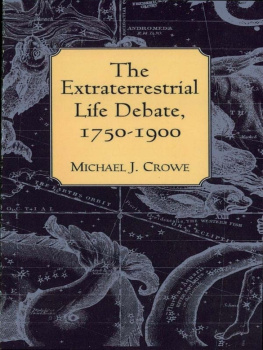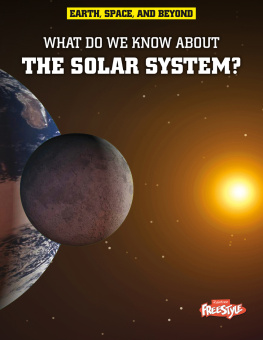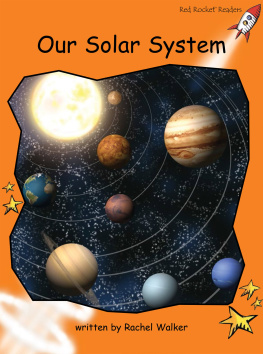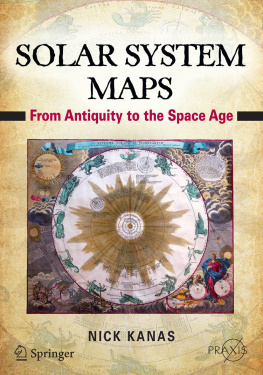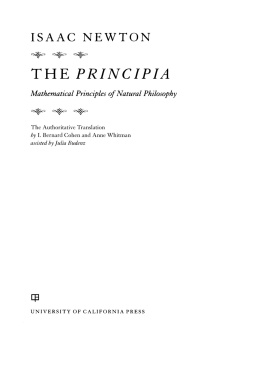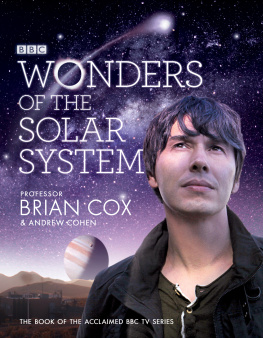Theories of the World
from Antiquity to the
Copernican Revolution
Second Revised Edition
Michael J. Crowe
Cavanaugh Professor in
the Program of Liberal Studies at
the University of Notre Dame
DOVER PUBLICATIONS, INC.
Mineola, New York
To
Patricia Clare Crowe
and
Catherine Mary Crowe
Copyright
Copyright 1990, 2001 by Michael J. Crowe
All rights reserved.
Bibliographical Note
Theories of the World from Antiquity to the Copernican Revolution is an original work, first published by Dover Publications, Inc., in 1990. For this new edition, published in 2001, the author has made a number of additions and corrections.
Library of Congress Cataloging-in-Publication Data
Crowe, Michael J.
Theories of the world from antiquity to the Copernican Revolution / Michael J. Crowe.2nd rev. ed.
p. cm.
Includes bibliographical references and index.
ISBN 0-486-41444-2 (pbk.)
1. AstronomyHistory. I. Title.
QB15 .C77 2001
520.9dc21
00-046870
Manufactured in the United States by Courier Corporation
41444205
www.doverpublications.com
Preface
What This Book Is, and What It Is Not
One way to describe this book and its limitations is to offer, as was common among eighteenth-century authors, an extended title: A Selective History, Employing Elementary Geometrical Methods and Passages from the Writings of Ptolemy and Copernicus, of Theories of the Planetary System from Antiquity to 1615. A briefer if more ambiguous title would be: Given the Evidence in 1615, Which Theory of the Planetary System (the Ptolemaic, Copernican, Tychonic, etc.) Was Most Deserving of Support at That Time? As will be suggested subsequently, answers to this question have significant historical and philosophical implications.
A second way of characterizing the contents of this volume is to provide an account of its origin. Around 1976, after teaching these materials for fifteen years at the University of Notre Dame, I began to compile portions of them into class handouts. Within a decade they had grown into a book-length manuscript, prepared without any idea that it might eventually be published. A summers support from a National Endowment for the Humanities grant to Notre Dame for course development provided the opportunity to make a thorough revision of the materials and to put them into a word processor. The need for such materials arose from the fact that, although a number of excellent books cover this topic, none quite suited the needs of my students, who, although not yet ready for the technicalities treated in, say, Dreyers classic History of Astronomy from Thales to Kepler, were nonetheless willing to explore these materials in a way that does not neglect their mathematical character. Fortunately, the mathematical techniques essential for a sound understanding of the great astronomical debate surveyed in this book are within the reach of anyone with good high-school training in mathematics and a willingness to use it. It also seemed advantageous to include readings from Ptolemy and Copernicus, who were the central figures in this debate. And it has proved to be an engaging approach to organize the materials so as to prepare readers to debate whether, given the evidence in 1615, they would have opted for a geocentric or heliocentric universe. Every year since 1976, these materials have been tested in the classroom and subsequently revised and updated. Not long ago, a colleague, Professor Andr Goddu, who has also used these materials in his classes, suggested that they be offered to a publisher. The ideal choice seemed Dover, which press has for decades provided readers interested in the history of scientific thought with books distinguished both by high-quality contents and low price. Dovers decision to publish it provided the opportunity for a final careful revision, designed to direct it to a larger public, while preserving those characteristics that have made it useful to the students the author has been privileged to teach.
This narrative of the origin of the book suggests to the reader that this volume is not a contribution to specialized research on the history of pre-1615 astronomy, for which many scholars possess superior credentials. It has rather been prepared to increase the accessibility of the writings of these scholars and of the great scientists whose writings they have so illuminated. The history provided is also selective, being organized chiefly around the aforementioned question.
Three Points of View
This book can be read more or less simultaneously from three different points of view: the scientific, the historical, and the philosophical.
If read for its scientific content, this book should provide a sound introductory knowledge of the astronomy of our solar system. The presentations of these ideas have been designed so as to draw, directly or indirectly, on the writings of a number of the most brilliant scientists of the past. Many of these ideas, being difficult, will challenge the readers abilities and ingenuity. Nonetheless, being fundamental for an understanding of the world, they are essential to a liberal education. It is an irony of current educational practice that whereas everyone believes the earth orbits the sun, few persons can cite the evidences that led to this conviction. Numerous presentations of the astronomy of the solar system are available; what makes the following presentation different from most of these are two features. On the one hand, the materials are presented historically (more on this shortly). On the other hand, the materials are set out so as to give primacy to an understanding of the scientific ideas involved. Each idea is carefully explained in such a way that only a minimum of background information is necessary for its comprehension. The use of a mathematical approach in presenting these ideas derives from the conviction that the most clear, direct, and effective way to an understanding of not only the scientific, but also the historical and philosophical features of the Copernican revolution, is through mathematics. This is not to say that mathematics alone is sufficient; it is only to suggest that Copernicus was correct when in the preface to his great work, he stressed that in a fundamental way, mathematics is necessary for an appreciation of his arguments. One irony of the study of the Copernican revolution as herein presented is that it is only by studying it from a mathematical point of view that one can fully understand the crucial historical point that mathematics alone was insufficient for both its creation and its resolution.
Second, the materials can also be read for their historical content. The Copernican revolution ranks as one of the most important developments in the entire history of thought. Moreover, the story of how humans came to create and then abandon the Ptolemaic system is among the most interesting and dramatic narratives in all of history. The reader should be aware that in the following materials, this story is not presented in its full richness; in particular, many individuals and events, important in their own right but not essential to the mainline of this drama, have not been included. To cite two examples, the impressive astronomical methods developed in antiquity by the Babylonians have been passed over with only the briefest mention, and the significant advances in astronomy during the medieval period have also received less attention than would be expected in a study claiming comprehensiveness. The main justification for such omissions is that the materials have been selected so as to provide a knowledge of developments involved in a single grand-scale episode in the history of astronomy: the Copernican revolution. The goal behind this method of proceeding is to involve the reader as fully and directly as possible in this single episode, to provide an understanding of the ideas and problems of the individuals who played the most crucial roles in that episode.


